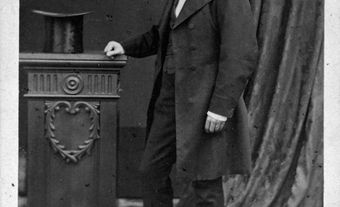This article was originally published in Maclean’s magazine on January 31, 2000. Partner content is not updated.
Warm Winter Holidays
It was a case of divine intervention. For the past five years, Heather Jones and Carolyn Harrisson have attended the 11 o'clock service at Calvary Church in St. Catharines, Ont., with their children and husbands. After a recent service, Harrisson sidled up to Jones and said: "I've got to get out of here. I need some sun." Well, praise the Lord and phone the travel agent. That was all the encouragement Jones, 34, needed. Four days later, she and 36-year-old Harrisson had ditched the kids, left their husbands with meal plans and were on a charter plane for a weeklong holiday in Cancun, Mexico. With six bikinis between them, these working mothers spent last week's cross-Canada cold snap lying on a beach with sand like talcum powder. Their toughest decision? Whether to order melon or strawberry margaritas under a blistering sun. "We didn't care where we went," said Jones, who works part-time in a bridal salon. "We just wanted sun and a beach, even if we had to sleep in a tent."
They aren't alone. After a few years of staying home with the sagging loonie, millions of Canadians are in the mood to down tools and dash off for a week or two out of the frozen north. In an annual poll in October of Canadian winter travel intentions, the Canadian Tourism Research Institute found that 45 per cent of Canadians expect to take a winter trip to the sun. That's an increase of almost 30 per cent over the number who intended to take such a vacation in the fall of 1998 - and the highest number in the past six years. Those who track leisure habits and economic indicators view the bite of the winter travel bug as a sign of confidence in the economy. Still, Harry French, the director of the Ottawa-based Canadian Tourism Research Institute (a division of the Conference Board of Canada), finds the swiftness of travel's rebound surprising, given that the dollar is still only worth 69 cents of its American counterpart. "Canadians are much more in the mood to spend," says French. "And the dollar is not inhibiting as much as it used to."
It couldn't keep Terry Drudge, a 53-year-old senior sales rep, from hopping a plane solely to play golf at the Caribbean Village Playa Grande resort in Puerto Plata, Dominican Republic. He played six days out of seven on a course that runs by the ocean, where the fairways are curbed by 30-m cliffs that fall to the sea. "It was more spectacular than Pebble Beach," the famous California course, raves Drudge, who lives in Elmira, Ont. Tim Fernback and Anne Carrell of Vancouver were more in the mood for an exotic vacation, and recently spent a week in Cozumel, Mexico, where they swam with dolphins and went scuba diving. Their only regret: not enough time to see the Mayan ruins.
The cold, too, has helped to whet this appetite for adventure and loosen the purse strings. Blizzards pounded the Atlantic provinces last week, while the windchill took temperatures to below -40° C in Central Canada, and British Columbians braced against 80-km/h winds. For the travel industry - already buzzing with talk of pent-up consumer demand from stay-at-home Canadians and heady predictions of a great March break - "this is like a gift from God," says Jill Wykes of Toronto-based Sunquest Vacations. "Everyone is reporting greater activity out there."
And where is the sun-deprived Canadian heading? While the Caribbean in general is hot, tour operators can single out three specific areas that are sizzling. Canadians are snapping up package tours to the Dominican Republic, Cuba and Mexico's Mayan Riviera - looking for golf vacations, quiet beaches or Jeep safaris through tropical jungles.
The Dominican Republic, which is slightly smaller than Nova Scotia, now boasts 40,000 hotel rooms. But these aren't the numbers that count for Canadians; they care more about the way their dollar stretches on this island. They are drawn by an ever-greater and affordable choice of "all-inclusive" vacations - where one up-front price paid back home covers airfare, accommodation, food, unlimited alcohol and resort activities like windsurfing and tennis. It's a concept that has spread through all the popular Caribbean and Mexican destinations and about two-thirds of Canada's sun-seekers are now travelling on all-inclusive winter packages. How inexpensive is a week under the palm trees? It all depends on the star-rating of the resorts and the time of year. But this week, tourists heading to the D.R. will pay as little as $999 each for an all-inclusive trip to a resort 10 minutes from Puerto Plata - that's a huge saving on separate billings for airfare, hotel, meals and booze.
If Canadians are going to get burned, they only want it to happen at the beach. The "all-in" method of travel has even drifted up the food chain to the most luxurious resorts. At the five-star Melia Tropical resort in the Dominican's Punta Cana, a small train takes guests to their villas, five à la carte restaurants dot the site, and a private concierge tends to the fussiest needs. Total cost in February: from $1,600 per person a week. At the Royal Hideaway in Playacar, Mexico, guests are pampered with extras like a glass of champagne at check-in, and are offered 24-hour room service and a choice of linen or cotton sheets when they arrive. This all-inclusive vacation runs to $2,600 a person. Clauderic St. Amand, vice-president of national sales and marketing for the Montreal-based tour operator Air Transat Holidays, says Canadians are fickle consumers of these packages - and "the toughest to please. The hoteliers tell us our clients are a pain in the neck. They wander around the resorts with their brochures to find the things that are missing."
But for Janina Paczuski, a Toronto high-school teacher, everything was spot-on during her two-week, all-inclusive trip to Varadero Beach, Cuba. "For me, Cuba is sitting by the pool, or by the ocean, drinking cuba libres," she says. "There are discos and water sports; there is so much to do." And a lot, too, for her kids - Jeremy, 23, Jessica, 12, and Jonathan, 8. When the younger boy got swimmer's ear and couldn't go in the pool for several days, he hung out in the resort's computer room, becoming expert on some video games. "He never once got bored," Paczuski says.
Today, Cuba appears a far cry from its image a decade back of poor service, middling food and little to do. It has 31,000 hotel rooms, many of them at Canadian- and European-owned luxury resorts with imported chefs. The country has developed new tourist areas - like Cayo Guillermo, one of a group of cays located off its northern shore. There are seven new hotels in the area and the state is building a new international airport there. Gordon MacQueen, the Charlottetown-based proprietor of MacQueen's Island Tours Ltd. - which organizes cycling vacations - has watched Cuba's progress with interest. "They are building hotels just as fast as they can," says MacQueen, who started running bicycle tours in Cuba after it traded sugar with China in 1991 for two million bicycles. (The intent was to keep citizens mobile in a country known for museum-piece cars as a result of the American trade ban.) He says the main tourist area of Varadero has changed radically in five years. "Canadians love it and Americans would flip over it because it's just like Cancun." It's like the pre-Castro days, he says, "except there is no gambling."
One of the hottest destinations for Canadians looking for a sun fix is the strip of coastline running south of Cancun and a ferry ride away from Cozumel. Dubbed the Mayan Riviera by clever tour operators, this 130-km corridor of tropical vegetation, white beaches and upscale resorts is Mexico's fastest-growing vacation playground - and one of the reasons that the $8-billion tourism industry is now more profitable than the state-owned oil industry.
For the past 15 years, former Vancouverite Rick Jones, 47, has watched wide-eyed as the area changed from a sleepy paradise where pigs roamed unpaved streets to a thriving hot spot that in a few years will offer as many as 24,000 hotel rooms. In 1983, Jones was working for the now-defunct Vancouver Holistic Health Centre and decided to drive to Mexico for a holiday. When he reached the village of Playa del Carmen, now the commercial hub of the Mayan Riviera, there was one telephone, and no streetlights or road signs. Travellers could rent a hammock for $2 a night and sleep on the beach. A bearded, beaded hippie, Jones had an entrepreneurial streak. He cobbled together $11,000 and a year later opened the funky and now-famous Blue Parrot Inn, which fronts on the topless Playa del Carmen beach.
"When I started, I had one room for rent and had to borrow a toilet," says the ponytailed Jones, who's known to the locals as "Mr. Rick." Last year, he expanded - adding 33 beachfront condominiums, designed by a Vancouver Island architectural firm. They sold quickly for between $150,000 and $300,000, and construction will soon begin on another 30 condos. The development boom has caused environmentalists to fear for the natural habitats of birds and sea turtles along the coastline. But the village of Playa del Carmen retains its charm with an eclectic mix of restaurants, quirky hotels and Mexican curio shops. Jones thinks the handful of big-name U.S. stores don't fare well there. "This is the best example in the world of small is beautiful."
Less commercial and more unusual are a good fit for those who are turning their sights back to the south. While Canadians appear starved for winter travel, their taste in vacations is definitely changing. In the early '90s, the trend was that winter vacationers from the western provinces went to California and Hawaii and some to Arizona, while Canadians in Central and Eastern Canada headed to Florida. It was a historic migration path, which generations had followed. While the traditional destinations are still popular, greater numbers of Canadians - especially the younger ones - are roaming to non-U.S. Sunbelt destinations. Last decade, a period of fewer international trips because of a weakening loonie, the Caribbean area saw a jump of 25 per cent in the number of tourists from this country. During the same period, the United States as a whole experienced a decline of the same percentage (although a few states had individual gains with the Canadian market).
"The older generation had tremendous travel loyalty and wanted a certain comfort zone, no surprises," said Martha Chapman, manager of corporate communications for Signature Vacations. "Each year, they'd travel to the same place and say: 'There's our water,' again." But Vancouverites Fernback, 32, and Carrell, 29, went to Hawaii last winter and found it pricey and predictable. When 50 of their friends raved about a New Year's Eve bash and splash in Mexico, the couple almost immediately headed for Cozumel's pristine beaches and startlingly azure waters. "We wanted something less Americanized, something a little more exotic," said Fernback, manager of corporate finance for Wolverton Securities Ltd.
After a sun-drenched week that left both with the tourist tattoo - a peeling red nose - the couple took a 45-minute ferry ride across to Playa del Carmen to check out other resorts for a possible return trip next year. For Fernback, scuba diving off the famed Mayan reef will bring him back. For Carrell, the safety and ease of travelling in a Spanish-speaking country and the unremittingly amiable locals will do the same. And the cheap prices won't hurt, either. In Hawaii, a snorkelling outing last year cost them $120, but was a third that in Mexico. "We spent a lot of money in Hawaii," said Fernback, who paid about $1,200 for his Mexican trip, including airfare, accommodation, food and drinks.
Florida has taken the change in travel tastes on the chin. In 1998, the number of Canadian visitors fell to 1.72 million - a precipitous plunge of 18 per cent from the previous year and the worst Canadian turnout on its beaches in a decade. While the tourism institute sees a slight rebound in Florida's fortunes - 200,000 more Canadians intend to travel there this winter than in 1998-1999 - even state tourist officials admit the poor numbers are not just tied to the difference in dollar values. And most Canadian travel experts agree that a chunk of the state's No. 1 international tourist market is gone for good. "Florida still gets the snowbirds," says Chapman. "But they are losing the incremental travellers. Florida used to be the chosen destination for college students, but now we're seeing that age group go to the Dominican Republic or Mexico because they can afford it and there are no budgeting surprises."
Statistics show that non-traditional U.S. destinations are also capitalizing on a more adventuresome Canadian market. With the exception of a grossly overpriced New Year's period - which flopped with tourists - Las Vegas is luring northerners in droves. For the family vacation, Texas has made great strides with a corny, but effective, coupon program called Buckaroo Buck$ (which offers deep discounts and, in some cases, Canadian dollars at par). In the fourth quarter of 1998, Texas saw 58 per cent more Canadians than it had in the same quarter the year before. Meanwhile, Arizona is making big gains among the large populations of Ontario and Quebec. In 1998, more people from Ontario than the much-closer British Columbia vacationed in Arizona.
But in pure numbers, it is the Caribbean countries and Mexico that are making the most impressive gains - by aggressively courting Canadians and making it easier for them to get to those prepaid hotel rooms. Cuba, for instance, used to have flights only out of Toronto and Montreal. "Now, it's unbelievable," says Gabriel Alvarez, director of the Toronto-based Cuba Tourist Board. "We have direct flights out of British Columbia, Alberta, Manitoba, Saskatchewan, the Maritimes and Ottawa." In Vancouver, the travel-hungry are even game to spend 10 hours on a direct flight to the Dominican Republic for one of those "all-in" vacations.
As the bitter chill settles in, Canadians are clearly responding to the inducements of the tropics. Travel agents happily contemplate an end to lean winter seasons, while their customers book, pack and almost taste that first umbrella-topped drink.
HOT SPOTS:
CUBA
No. of Canadian tourists in
1995: 143,541
1999: 276,346
Percentage increase: 92.5
Canada's rank as a tourist market: No. 1
Number of hotel rooms: 31,000
Top destinations: Varadero, Jardines del Rey, Cayo Coco
Local specialties: the mojito (a cocktail of rum, lime juice, sparkling water, mint, sugar and ice); several brands of cigars; ajiaco, a thick vegetable and meat soup
Average February temperature: 23° C to 25° C
CUBA
No. of Canadian tourists in
1995: 143,541
1999: 276,346
Percentage increase: 92.5
Canada's rank as a tourist market: No. 1
Number of hotel rooms: 31,000
Top destinations: Varadero, Jardines del Rey, Cayo Coco
Local specialties: the mojito (a cocktail of rum, lime juice, sparkling water, mint, sugar and ice); several brands of cigars; ajiaco, a thick vegetable and meat soup
Average February temperature: 23° C to 25° C
MEXICO
No. of Canadian tourists in
1994-1995: 827,000
1998-1999: 1.2 million (Estimated figure based on fiscal year)
Percentage increase: 45
Canada's rank as tourist market: No. 2
Number of hotel rooms: 500,000
Top destinations: Acapulco, Cancun area, Puerto Vallarta
Local specialties: mole poblano (a sauce for chicken whose 21 ingredients include chilies and chocolate), margaritas and mescal
Average February resort temperature: 23° C to 28° C
DOMINICAN REPUBLIC
No. of Canadian tourists in
1995: 125,700
1999: 185,000 (Estimated)
Percentage increase: 47.2
Canada's rank as a tourist market: No. 3
Number of hotel rooms: 40,000
Top destinations: Puerto Plata, Punta Cana, Santo Domingo
Local specialties: a stew called sancocho; Cerveza Presidente, the top-selling beer; five brands of rum
Average February temperature: 25° C to 29° C
Maclean's January 31, 2000

 Share on Facebook
Share on Facebook Share on X
Share on X Share by Email
Share by Email Share on Google Classroom
Share on Google Classroom


